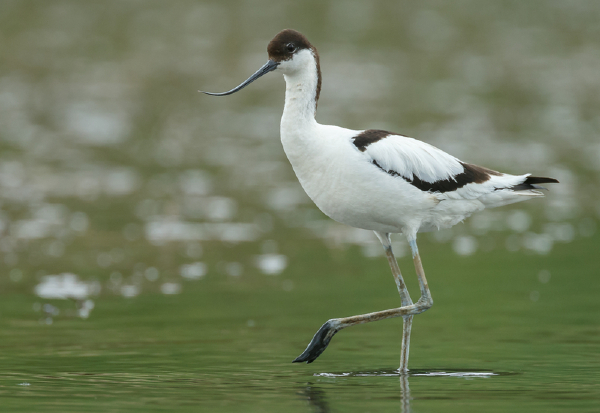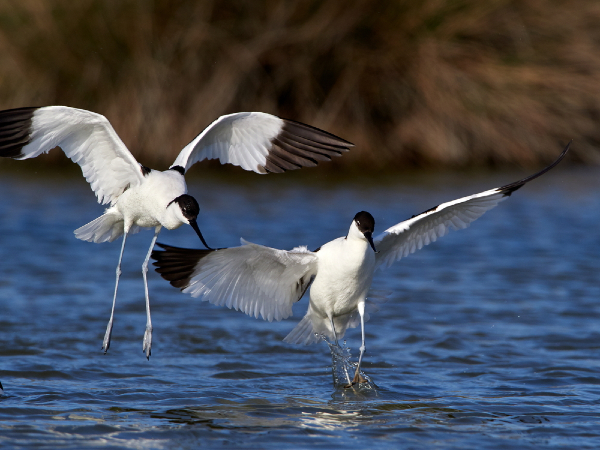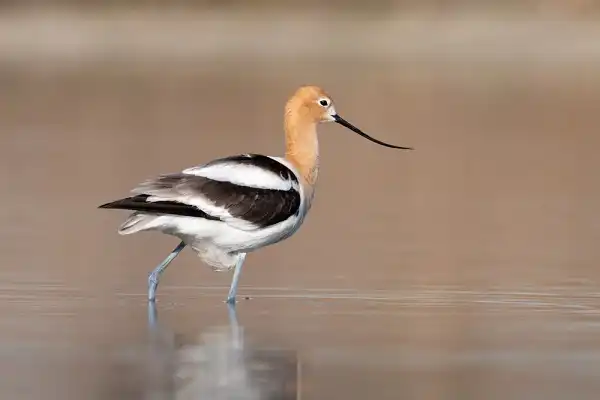The avocet is a unique bird that has an interesting history and behaviors. They are native to North America, Europe, and Asia, and they have been around for centuries. Avocets are known for their long legs and distinctive black and white plumage. They are also very social birds and can be seen in large flocks. Their feeding habits make them a fascinating bird to watch.

Avocet Description
The avocet is a large, long-legged wader species with a distinctive upturned bill. Its plumage is primarily black and white, with a boldly patterned face and striking orange legs. Avocets are strong fliers and use a variety of feeding techniques to find food in the wetlands where they reside. They typically forage by wading in shallow water, close to the water’s edge, or by flying low over the wetland surface while pecking at small prey. Avocets play an important role in their ecosystems as both predators and prey species, and they are an increasingly popular subject of study among wildlife enthusiasts. If you’re looking to get up close and personal with these graceful birds, a visit to your nearest wetland habitat is definitely in order!
Avocet Habitat
Avocets typically prefer locations with expansive open marshes or wetlands, where they can forage for small aquatic prey and build their nests. Because these habitats are often subjected to fairly frequent flooding and storm events, they must be relatively resilient in order to provide a suitable avocet habitat. This resilience can be provided by certain types of plants like cattails and sedges, which help to reduce the erosion of vulnerable marsh soils. In addition, avocets rely on having an abundance of small invertebrates like insects, snails, and crustaceans as food sources, so wetlands that have high levels of nutrients and productivity tend to be more favorable to them as well. Overall, avocets are an indicator species for the health of their unique habitat and can serve as an important conservation tool for researchers working to protect this vital ecosystem.
Avocet Diet
The avocet diet consists primarily of small aquatic creatures, such as insects, crustaceans, and mollusks. The long, curved bill of the avocet is well-suited for probing in mud and sand to find food. Avocets will also occasionally eat plant matter, such as seedpods or algae. In some parts of the world, avocets are considered to be a nuisance because they can damage rice fields and other agricultural crops. However, in many places, they are also valued for their role in controlling insect populations.

Avocet Size
Avocets are typically about 16 inches long and have a wingspan of about 24 inches. Avocets are found in marshes, ponds, and other wetland habitats. They feed on small animals, such as insects and crustaceans. Avocets sometimes form large flocks, especially during migration. The largest flock ever recorded was nearly 100,000 birds strong!
Avocet Lifespan
Avocets are long-lived birds, with a typical lifespan of between 10 and 15 years. This relatively high lifespan is mainly due to the avocet’s strong immune system and highly efficient metabolism. Avocets are also fairly adaptable, so they are able to survive even in harsh environmental conditions. Their ability to forage for food on both land and water also helps them to find plenty of nutrients that promote healthy growth and development. Overall, these traits ensure that avocets are able to live long, healthy lives and reproduce effectively during their time on Earth.
Avocet Behavior
Avocets are known for their distinctive feeding behaviors, which involve sweeping the surface of the water with their beaks to filter out small aquatic organisms. Avocets also display many different social and mating behaviors, including elaborate dances and distinctive rituals performed during courtship. Avocet behavior generally varies depending on a number of factors, including breeding season, age, and habitat type. Overall, avocets exhibit intriguing and complex behaviors that help to make these animals a subject of fascination for biologists and birdwatchers alike.

Avocet Speed
Avocet birds are known for their remarkable speed and agility. These striking black and white birds can fly at speeds of up to 60 miles per hour, making them one of the most nimble species in all of nature. Avocets can dart through the air with lightning-fast swoops, performing complex aerobatic maneuvers that seem almost impossible for such a large bird. Furthermore, these remarkable birds also use their incredible speed and agility as a defense mechanism, swooping quickly down on potential predators or enemies to scare them away from their territory. While avocets may seem unassuming at first glance, it is clear that these birds are truly something special. Their impressive speed and agility make them an awe-inspiring sight to behold.
Avocet Hunting
Avocet hunting is a popular sport in many parts of the world. When hunting Avocets, it is important to remember that they are protected under the Migratory Bird Treaty Act. As such, it is illegal to hunt them without a permit. Avocet hunting can be an enjoyable and challenging sport, and it is a great way to enjoy the outdoors while also helping to conserve these beautiful birds.

Conclusion
The avocet bird is a beautiful and unique creature. If you’re ever in the area around Austin, Texas, be sure to keep an eye out for them; they are definitely worth seeing.
Frequently Asked Question

